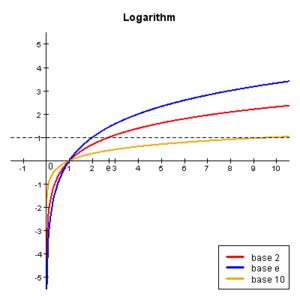Difference between revisions of "Natural logarithm"
From Conservapedia
m |
m |
||
| Line 15: | Line 15: | ||
| − | Proof: If <math>p</math> is a positive integer, this just follows from repeated application of the above-mentioned additive property of the logarithm. For <math>p = \frac{1}{n}</math>, note that the statement follows by observing that <math>\ln(x) = \ln((x^{1/n})^n) = n\ln(x^{1/n}</math>. Thus, <math>p\ln(x) = \ln(x^p)</math> for all rational numbers <math>p</math>. The statement must therefore hold for all reals <math>p</math> by continuity. | + | Proof: If <math>p</math> is a positive integer, this just follows from repeated application of the above-mentioned additive property of the logarithm. For <math>p = \frac{1}{n}</math>, note that the statement follows by observing that <math>\ln(x) = \ln((x^{1/n})^n) = n\ln(x^{1/n})</math>. Thus, <math>p\ln(x) = \ln(x^p)</math> for all rational numbers <math>p</math>. The statement must therefore hold for all reals <math>p</math> by continuity. |
Revision as of 00:57, May 26, 2009
The natural logarithm,  is the inverse of the function
is the inverse of the function  . In other words, if
. In other words, if  , we define
, we define  .
.
The natural logarithm has some interesting properties that follow from the multiplicative properties of  . The natural logarithm is also particularly useful in calculating interest.
. The natural logarithm is also particularly useful in calculating interest.
Properties of the Logarithm
 for all positive reals
for all positive reals  .
.
Proof: If  , we can write
, we can write  and
and  . It follows that
. It follows that  . By definition,
. By definition,  . This last expression, of course, is
. This last expression, of course, is  .
.
Proof: If  is a positive integer, this just follows from repeated application of the above-mentioned additive property of the logarithm. For
is a positive integer, this just follows from repeated application of the above-mentioned additive property of the logarithm. For  , note that the statement follows by observing that
, note that the statement follows by observing that  . Thus,
. Thus,  for all rational numbers
for all rational numbers  . The statement must therefore hold for all reals
. The statement must therefore hold for all reals  by continuity.
by continuity.
Proof:  , whence we must have
, whence we must have  .
.

